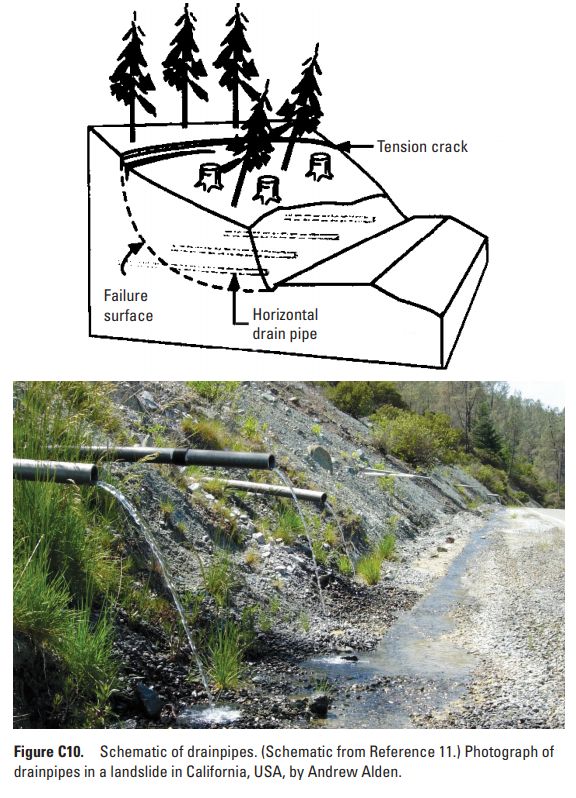61 Human Impact on Mass Movement
Humans can contribute to mass wasting in a few different ways:
- Excavation of slope or its toe
- Loading of slope or its crest
- Drawdown (of reservoirs)
- Deforestation
- Irrigation
- Mining
- Artificial vibration
- Water leakage from utilities
Prevention and Awareness
As already noted, we cannot prevent mass wasting in the long term as it is a natural and ongoing process; however, in many situations there are actions that we can take to reduce or mitigate its damaging effects on people and infrastructure. Where we can neither delay nor mitigate mass wasting, we should consider moving out of the way.
Porteau Cove, BC, Canada. 2008 Landslide (rockfall).
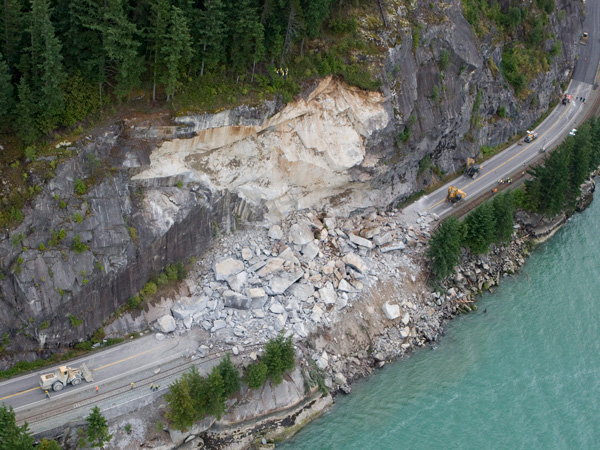
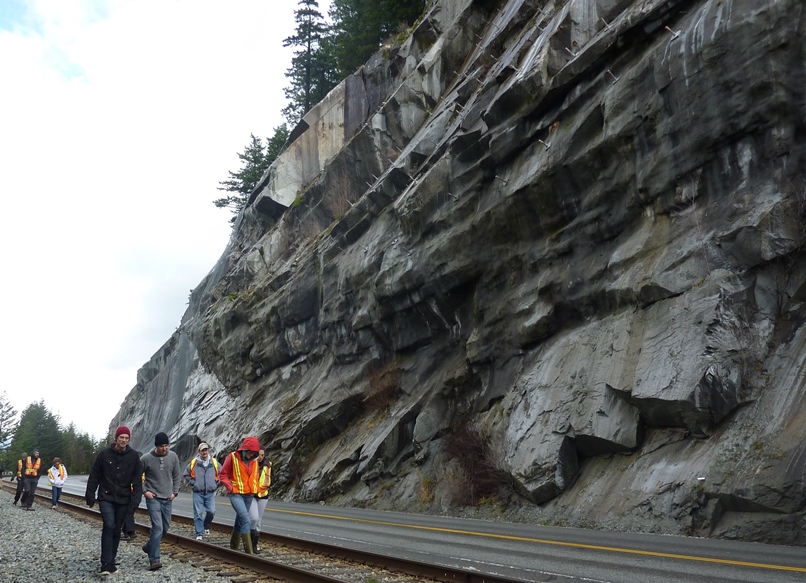
What we have to remember is that the works of humans are limited compared to the works of nature. The rock bolts in the road cut at Porteau Cove will slowly start to corrode after a few years, and within a few decades, many of them will begin to lose their strength. Unless they are replaced, they will no longer support that slope. Likewise, drainage holes at the Downie Slide will eventually become plugged with sediment and chemical precipitates, and unless they are periodically unplugged, their effectiveness will decrease.
Eventually, unless new holes are drilled, the drainage will be so compromised that the slide will start to move again. This is why careful slope monitoring by geological and geotechnical engineers is important at these sites. The point here is that our efforts to “prevent” mass wasting are only as good as our resolve to maintain those preventive measures.
Delaying mass wasting is a worthy endeavor, of course, because during the time that the measures are still effective they can save lives and reduce damage to property and infrastructure. The other side of the coin is that we must be careful to avoid activities that could make mass wasting more likely.
One of the most common anthropogenic causes of mass wasting is road construction, and this applies both to remote gravel roads built for forestry and mining and large urban and regional highways. Road construction is a potential problem for two reasons.
First, creating a flat road surface on a slope inevitably involves creating a cut bank that is steeper than the original slope. This might also involve creating a filled bank that is both steeper and weaker than the original slope (Figure 2).
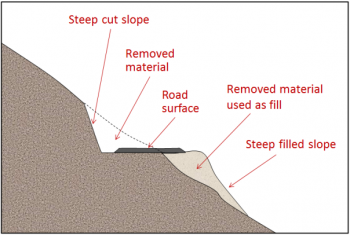
Second, roadways typically cut across natural drainage features, and unless great care is taken to reroute the runoff water and prevent it from forming concentrated flows, over-saturating fill of materials can result.
Apart from water issues, engineers building roads and other infrastructure on bedrock slopes have to be acutely aware of the geology, and especially of any weaknesses or discontinuities in the rock related to bedding, fracturing, or foliation. If possible, situations like that at Porteau Cove (Figure 1) should be avoided — by building somewhere else — rather than trying to stitch the slope back together with rock bolts.
It is widely believed that construction of buildings on the tops of steep slopes can contribute to the instability of the slope. This is probably true, but not because of the weight of the building. As you’ll see by completing the exercise below, a typical house isn’t usually heavier than the fill that was removed from the hole in the ground made to build it. A more likely contributor to instability of the slope around a building is the effect that it and the changes made to the surrounding area have on drainage.
EXERCISE: HOW MUCH DOES A HOUSE WEIGH AND CAN IT CONTRIBUTE TO A SLOPE FAILURE?
 It is commonly believed that building a house (or some other building) at the top of a slope will add a lot of extra weight to the slope, which could contribute to slope failure. But what does a house actually weigh? A typical 150 m2 (approximately 1,600 ft2) wood-frame house with a basement and a concrete foundation weighs about 145 t (metric tonnes).
It is commonly believed that building a house (or some other building) at the top of a slope will add a lot of extra weight to the slope, which could contribute to slope failure. But what does a house actually weigh? A typical 150 m2 (approximately 1,600 ft2) wood-frame house with a basement and a concrete foundation weighs about 145 t (metric tonnes).
But most houses are built on foundations that are excavated into the ground. This involves digging a hole and taking some material away, so we need to subtract what that excavated material weighs. Assuming our 150 m2 house required an excavation that was 15 m by 11 m by 1 m deep, that’s 165 m3 of “dirt,” which typically has a density of about 1.6 t per m3.
Calculate the weight of the soil that was removed and compare that with the weight of the house and its foundation.
If you’re thinking that building a bigger building is going to add more weight, consider that bigger buildings need bigger and deeper excavations, and in many cases the excavations will be into solid rock, which is much heavier than surficial materials.
You may wish to consider how a building might change the drainage on a slope. There are a number ways. Water can be collected by roofs, go into downspouts, and form concentrated flows that are directed onto or into the slope. Likewise drainage from nearby access roads, lawn irrigation, leaking pools, and septic systems can all alter the surface and groundwater flow in a slope.
Monitoring Mass Wasting
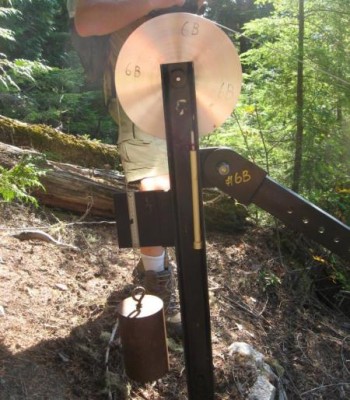 Figure 3. Part of a motion-monitoring device at the Checkerboard Slide near Revelstoke, B.C. The lower end of the cable is attached to a block of rock that is unstable. Any incremental motion of that block will move the cable, which will be detectable on this device. [SE]
Figure 3. Part of a motion-monitoring device at the Checkerboard Slide near Revelstoke, B.C. The lower end of the cable is attached to a block of rock that is unstable. Any incremental motion of that block will move the cable, which will be detectable on this device. [SE]
In some areas, it is necessary to establish warning systems so that we know if conditions have changed at a known slide area, or if a rapid failure, such as a debris flow, is actually on its way downslope. The Downie Slide above the Revelstoke Resevoir is monitored 24/7 with a range of devices, such as inclinometers (slope-change detectors), bore-hole motion sensors, and GPS survey instruments.
A simple mechanical device for monitoring the nearby Checkerboard Slide (which is also above the Revelstoke Reservoir) is shown in Figure 3. Both of these are very slow-moving rock slides, but it’s very important to be able to detect changes in their rates of motion because at both of these locations a rapid failure would result in large bodies of rock plunging into the reservoir and sending a wall of water over the Revelstoke Dam, potentially destroying the nearby town of Revelstoke.
Mt. Rainier, a glacier-covered volcano in Washington State, has the potential to produce massive mudflows or debris flows (lahars) with or without a volcanic eruption. Over 100,000 people in the Tacoma, Puyallup, and Sumner areas are in harm’s way because they currently reside on deposits from past lahars (Figure 4). In 1998, a network of acoustic monitors was established around Mt. Rainier. The monitors are embedded in the ground adjacent to expected lahar paths. They are intended to provide warnings to emergency officials, and when a lahar is detected, the residents of the area will have anywhere from 40 minutes to three hours to get to safe ground.

Mitigating the Impacts of Mass Wasting
In situations where we can’t predict, prevent, or delay mass-wasting hazards, some effective measures can be taken to minimize the associated risk. For example, many highways in B.C. and western Alberta have avalanche shelters like that shown in Figure 5. In some parts of the world, similar features have been built to protect infrastructure from other types of mass wasting.
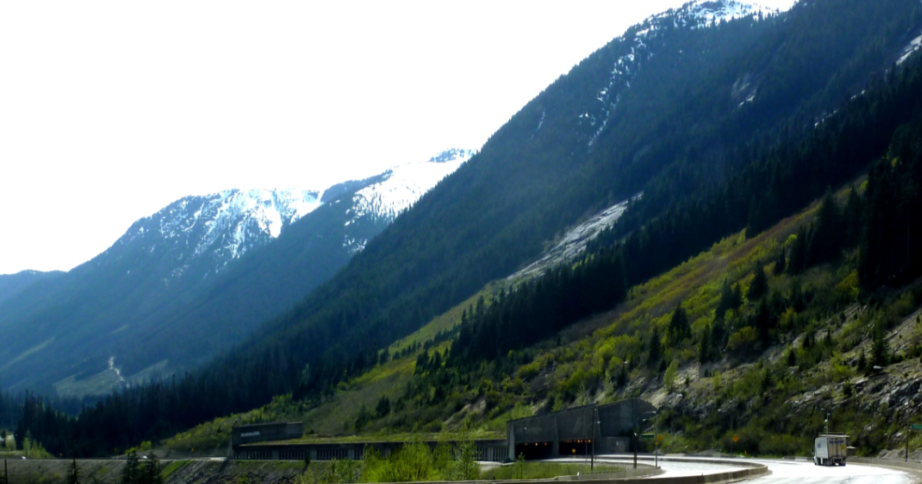

LANDSLIDE MITIGATION—HOW TO REDUCE THE EFFECTS OF LANDSLIDES
The hazard from landslides can be reduced by avoiding construction on steep slopes and existing landslides, or by stabilizing the slopes.
Stability increases when ground water is prevented from rising in the landslide mass by:
(1) covering the landslide with an impermeable membrane,
(2) directing surface water away from the landslide,
(3) draining ground water away from the landslide, and
(4) minimizing surface irrigation. Slope stability is also increased when a retaining structure and/or the weight of a soil/rock berm are placed at the toe of the landslide or when mass is removed from the top of the slope.
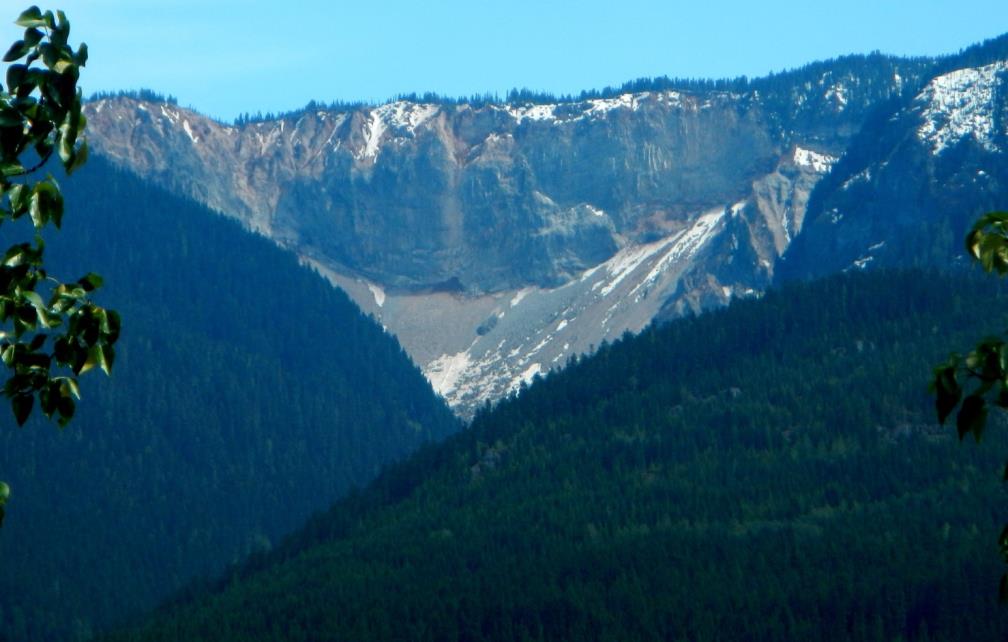
Finally, in situations where we can’t do anything to delay, predict, contain, or mitigate slope failures, we simply have to have the sense to stay away. There is a famous example of this in B.C. at a site known as Garibaldi, 25 km south of Whistler. In the early 1980s the village of Garibaldi had a population of about 100, with construction underway on some new homes, and plans for many more.
In the months that followed the deadly 1980 eruption of Mt. St. Helens in Washington State, the B.C. Ministry of Transportation commissioned a geological study that revealed that a steep cliff known as The Barrier (Figure 7) had collapsed in 1855, leading to a large rock avalanche, and that it was likely to collapse again unpredictably, putting the village of Garibaldi at extreme risk. In an ensuing court case, it was ruled that the Garibaldi site was not a safe place for people to live. Those who already had homes there were compensated, and everyone else was ordered to leave.
Features that might indicate landslide movement:
- Springs, seeps, and wet or saturated ground in previously dry areas on or below slopes.
- Ground cracks—cracks in snow, ice, soil, or rock on or at the head of slopes.
- Sidewalks or slabs pulling away from structures if near a slope; soil pulling away from foundations.
- Offset fence lines, which were once straight or configured differently
- Unusual bulges or elevation changes in the ground, pavements, paths, or sidewalks.
- Tilting telephone poles, trees, retaining walls, fences.
- Excessive tilting or cracking of concrete floors and foundations.
- Broken water lines and other underground utilities.
- Rapid increase or decrease in stream-water levels, possibly accompanied by increased turbidity (soil content clouding the water).
- Sticking doors and windows and visible open spaces, indicating walls and frames are shifting and deforming.
- Creaking, snapping, or popping noises from a house, building, or grove of trees (for example, roots snapping or breaking).
- Sunken or down-dropped roads or paths.
Can we ever predict landslides?
